Thanks Eric – much appreciated!
A few questions -
first – Wondering why folks thinks I am not doing an OCW?
Second - the 44.2 grains I assume it is because I am at the low end of the temperature range i.e. 46 degree and so I can use the low end of where there is no significant movement of POI? I agree but just wanted to see if this is your rationale.
Third – Going with 44.2 grains, I assume I should still do seating depth optimization in 0.003†intervals?
jlow said:
first – Wondering why folks thinks I am not doing an OCW?
"Optimal Charge Weight" load development is superficially similar, but different in several specifics, and it is a named approach which a chap Dan Newberry claims is all his:
http://optimalchargeweight.embarqspace.com/#/ocw-instructions/4529817134
Also, it's worth going back to Pages
1 and
2 of this thread and search for "OCW", there was some discussion worth reviewing.
Erik Cortina said:
jlow said:
Did an OCW with my 24†AI AT 308 today and here are the results: Berger 185 Juggernaut, Varget, Lapua brass, Tula LRP. Bullets seated to 0.010†jump. Conditions: 46 degree, 80 humidity, pressure at 29.23. Powder range 44.0 to 44.8 grains at 0.2 grain interval – no pressure signs. QL predicted OCW at 44.5 grains.
Top right 3 rounds fouler done with cheap Win brass/175 SMK/42 grain Varget so ignore.
Plotted average POI using OT data with red dots and arrows showing movement. Looks like average POI for the 5 groups did not change much within powder range tested. Probably the most movement outside group was the first charge i.e. 44.0 grains.
MV captured with Ohler 36p. Average MV linear within powder range. All groups had single digit SDEV.
First question is what’s next? Since the average POI did not move much and group size was small, should I still try to optimize with seating depth adjustment?
I would go with 44.2
Eric,
As the 44.2 is just one 3 shot group, would you to shoot additional groups (6?) to see if 44.2 is statistically significant before you move on to seating depth?
Ben
Team Lapua Brux Borden Captain
BenPerfected said:
Erik Cortina said:
jlow said:
Did an OCW with my 24†AI AT 308 today and here are the results: Berger 185 Juggernaut, Varget, Lapua brass, Tula LRP. Bullets seated to 0.010†jump. Conditions: 46 degree, 80 humidity, pressure at 29.23. Powder range 44.0 to 44.8 grains at 0.2 grain interval – no pressure signs. QL predicted OCW at 44.5 grains.
Top right 3 rounds fouler done with cheap Win brass/175 SMK/42 grain Varget so ignore.
Plotted average POI using OT data with red dots and arrows showing movement. Looks like average POI for the 5 groups did not change much within powder range tested. Probably the most movement outside group was the first charge i.e. 44.0 grains.
MV captured with Ohler 36p. Average MV linear within powder range. All groups had single digit SDEV.
First question is what’s next? Since the average POI did not move much and group size was small, should I still try to optimize with seating depth adjustment?
I would go with 44.2
Eric,
As the 44.2 is just one 3 shot group, would you to shoot additional groups (6?) to see if 44.2 is statistically significant before you move on to seating depth?
Ben
Actually, I would work on seating depth first and then come back afterwards and test in 0.1 gr. increments with 5 shot groups 0.5 gr. on each side of node.
Yes, I am familiar with OCW as described by Dam Mewberry. It is definitely true that it looks like I cut some corners.

Part of it is I did not put up data showing the study I did where I looked for pressure sign going up the charge weight, I skipped it because there was nothing to see, MV went up linearly with increase in charge with and no pressure sign up to the powder range I tested which was used in the study I uploaded.
Now I definitely did not do the charge range study normally recommended by the study because I was able to calculate where the node was and only wanted to look around that charge weight to see what differences in POI was with around 1 grain change in powder. I could do lower but it is a waste of components are I will never go that low due to the lower MV and I would not go significantly higher as QL clearly tells me I cannot reach the next node.
I don’t jam because it is not necessary with this bullet and in fact it is better not to, so 10 thousands off the lands is a good starting point.
Thanks again Eric, will do the seating depth study and come back and optimize charge weight.
jlow said:
I don’t jam because it is not necessary with this bullet and in fact it is better not to, so 10 thousands off the lands is a good starting point.
If you review Page 1, Erik's OP, he suggests starting at .020" bullet jump, not at "jammed". He identifies the length to "jammed" only as the repeatable baseline from which bullet jump is measured. IMO if you are starting at .010", I would be sure to work back past .020" which covers the same ground as starting at .020" and working forward past .010".
First of all, jamming came from “horse’s mouth†i.e. Dan Newberry.
As for that magic 0.020†number, are you not being a bit OCD? ;D LOL!
I am sure if you ask Eric, he will tell you that those numbers 10-20 thousands are approximate guides and you need to use your head when using these numbers as per the components you are using. My own reason to use 10 is because for the Jugs, the generally accepted good jump numbers are indeed in that range and so starting from 10 and moving to a larger jump would be the obvious way to go. If I use 20 first, and it happens to work better at 10 that would mean I might have to reverse course or miss the boat...
There is no danger here and the load obviously is accurate, so although I appreciate the input, my recommendation is to chill out a bit. We are not experts but we are no dummies either, and there is no need to take those numbers as absolute gospel...
Team Lapua Brux Borden Captain
jlow said:
Thanks Eric – much appreciated!
A few questions -
first – Wondering why folks thinks I am not doing an OCW?
Second - the 44.2 grains I assume it is because I am at the low end of the temperature range i.e. 46 degree and so I can use the low end of where there is no significant movement of POI? I agree but just wanted to see if this is your rationale.
Third – Going with 44.2 grains, I assume I should still do seating depth optimization in 0.003†intervals?
The reason I suggested 44.2 is because 40.0, 40.2, and 40.4 would make a cluster group if you stacked all three targets on top of each other.
I personally like to test at least a 2.0 gr. Window to make sure I don't miss anything. In your case, I am curious what it would look like above 40.8 gr. because the Chronograph numbers started getting better the higher you went. As long as you have room to go pressure wise, I would test higher up regardless of what QL has to say.
jlow said:
... my recommendation is to chill out a bit.
"Physician, heal thyself!"
Erik Cortina said:
jlow said:
Thanks Eric – much appreciated!
A few questions -
first – Wondering why folks thinks I am not doing an OCW?
Second - the 44.2 grains I assume it is because I am at the low end of the temperature range i.e. 46 degree and so I can use the low end of where there is no significant movement of POI? I agree but just wanted to see if this is your rationale.
Third – Going with 44.2 grains, I assume I should still do seating depth optimization in 0.003†intervals?
The reason I suggested 44.2 is because 40.0, 40.2, and 40.4 would make a cluster group if you stacked all three targets on top of each other.
I personally like to test at least a 2.0 gr. Window to make sure I don't miss anything. In your case, I am curious what it would look like above 40.8 gr. because the Chronograph numbers started getting better the higher you went. As long as you have room to go pressure wise, I would test higher up regardless of what QL has to say.
Thanks Eric!
Sorry my OP was not so clear but here is an enlarged image of the average point of impact (POI) from the 5 groups that I got from OnTarget. You unfortunately cannot see this so well in the OP due to the file size limit but I’ve blown it up a bit and labeled the POI with dots. As you can see, there are 5 dots representing the 5 charges tested and the dot that is furthest out from the rest of the group is the 44.0 grain’s. So 44.2 would be the lowest charge which are in with that close cluster.
I agree with you about looking at a higher charge since the chrono numbers do start to look better. One reason I did not go higher is because at least according to Berger’s conservative numbers, I am already more than 3 grains above “Max Load†which is 41.6 grain for this bullet. I also did not go above 44.75 grain in my pressure test, and added with the QL node number, I stayed down there. However, I am not against going higher, just need to do it carefully and will work on that next.
Thanks again!
-
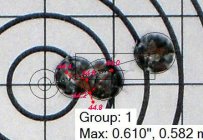
OCW.jpg
30.7 KB
· Views: 52
Went out today and did the seating depth study. Ended up using 44.3 grain of varget as QL suggest best for the temp today which was 36 degreeC. Reloading details same as before except for powder weigh, and seating depth which started 0.010†off touch and 0.003†deeper for each group.
As usual, top right group is fouler so ignore, and seating depth indicated for each group. MV generally good except for group 4 which had SDEV of 12 fps.
So superficially, it looks like 0.013†was best seating depth with group size of 0.141â€. The odd thing is it appears that every other group had either smaller or bigger group size. Anyone seen this before? Looks like the 3 best groups had average MV of 2628, 2629, 2629 fps i.e. they were the same whereas the wider groups were 2620, 2621, 1620, and 1638 fps i.e they were different... MV SDEV did not follow quite the same pattern. ???
-
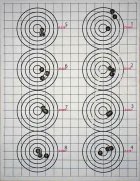
Seating depth.jpg
81.5 KB
· Views: 261
-
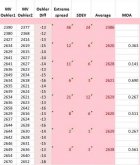
MV.jpg
33.5 KB
· Views: 141
Team Lapua Brux Borden Captain
YouTube channel
I started a YouTube Channel and will cover reloading topics. I am also planning to cover my reloading process in detail, so don't forget to subscribe.
I started a separate thread for my YouTube channel here:
http://forum.accurateshooter.com/index.php?topic=3862243.0
If you want to go directly to my YouTube channel, click here:
http://m.youtube.com/user/XtremeConcreteCo
If you like what you see on YouTube, don't forget to like the video and also subscribe. Thanks for your support guys!
.308 shot round robin at 100 yards. Bullet seating dept test.
Which would you use?
-

308 target 1.jpg
18 KB
· Views: 187
-
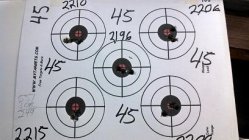
308 target 2.jpg
21.2 KB
· Views: 168
Team Lapua Brux Borden Captain
jlow said:
Went out today and did the seating depth study. Ended up using 44.3 grain of varget as QL suggest best for the temp today which was 36 degreeC. Reloading details same as before except for powder weigh, and seating depth which started 0.010†off touch and 0.003†deeper for each group.
As usual, top right group is fouler so ignore, and seating depth indicated for each group. MV generally good except for group 4 which had SDEV of 12 fps.
So superficially, it looks like 0.013†was best seating depth with group size of 0.141â€. The odd thing is it appears that every other group had either smaller or bigger group size. Anyone seen this before? Looks like the 3 best groups had average MV of 2628, 2629, 2629 fps i.e. they were the same whereas the wider groups were 2620, 2621, 1620, and 1638 fps i.e they were different... MV SDEV did not follow quite the same pattern. ???
Jlow, I see what you mean, it appears the seating depth window is very narrow, which suggests that all may not be well. Load the .013" seating depth and do a powder charge test in .1 increments, load .5 gr on each side of node. Watch for pressure signs as you go and stop if any are encountered.
Team Lapua Brux Borden Captain
Terry said:
.308 shot round robin at 100 yards. Bullet seating dept test.
Which would you use?
2.210 - 2.215look good. Load from 2.200 - 2.224 in .003" increments to verify.
Thanks Eric, will give it a go as per your suggestions.
The one thought that came to me looking at the group pattern is it sure resembles the group pattern the guys have been discussing on the recent “Tuner†thread where they describe it as a sine wave like pattern similar to this polynomial fit I put on the data plotting seating depth against group size. The only difference is I am changing seating depth vs. someone dialing his tuner. Might be pure co-incidence but it sure caught my eye.
-
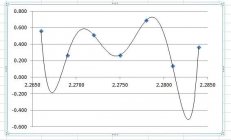
Sine.jpg
19.6 KB
· Views: 55
Transcendental Capitalist
Silver $$ Contributor
2014-1-11, BRRC Range, 100 Yards, Overcast & drizzle
.284 Win., 31"Benchmark bbl., Barnard action
Berger 180 Hyb,Lapua brass,4831sc)
53gr. appears to be a candidate
-
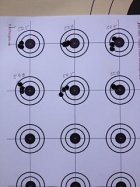
IMG_0980_2.jpg
15.1 KB
· Views: 173
Team Lapua Brux Borden Captain
Killick said:
2014-1-11, BRRC Range, 100 Yards, Overcast & drizzle
.284 Win., 31"Benchmark bbl., Barnard action
Berger 180 Hyb,Lapua brass,4831sc)
53gr. appears to be a candidate
Yes, 53.0 gr. looks good. Do you have any chronograph data?
Transcendental Capitalist
Silver $$ Contributor
Yes, the ES's and SD's are awful (20's and 30's). Average velocities seem high - 52.5gr.@2875, 53gr.@2925, 53.5gr.@2960, 54.5gr.@3010, 55gr.@3060. No sticky bolt lift, primers flattened at 54.5gr.
Team Lapua Brux Borden Captain
Killick said:
Yes, the ES's and SD's are awful (20's and 30's). Average velocities seem high - 52.5gr.@2875, 53gr.@2925, 53.5gr.@2960, 54.5gr.@3010, 55gr.@3060. No sticky bolt lift, primers flattened at 54.5gr.
Something does not seem right. Those speeds are way too fast for a .284 shooting 180's. Perhaps your chronograph is giving you some bad data.

















